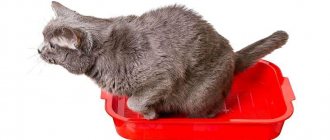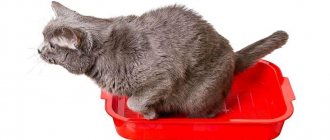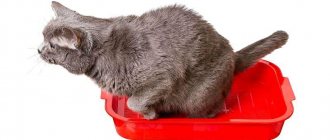The presence of scarlet drops or streaks in the feces is a signal that something is wrong in the cat’s body. This alarming symptom should not be ignored. After all, inaction can lead to severe internal bleeding and death of the pet. Therefore, it is important to understand the reasons for the appearance of blood in feces and in what cases the cat will need emergency hospitalization, and when treatment can be carried out at home.
Why does a cat poop blood?
If the owner regularly cleans the litter box, then without much difficulty and in time he will notice that his cat goes to the toilet with blood. Sometimes other impurities are found in stool that should not be there. For example, mucus, hair or helminth particles.
The most common reasons why this happens:
- Poor nutrition. If a cat is fed food from the human table - cereals, bread, or cheap cat food, this leads to digestive dysfunction. Your pet may become constipated, especially if there is insufficient drinking water. Dry feces damage the intestinal walls, so when your cat poops, blood appears in his stool.
- The pet eats bones. Cats should not be given bones, especially tubular ones, they are very hard and cannot be completely digested. Small sharp pieces injure the intestinal mucosa. As a result, the cat goes to the toilet with a lot of blood.
- A pet has swallowed a foreign body - a wood chip, a fragment of a toothpick, a small piece of plastic. Any small objects with sharp edges that injure the intestinal walls are dangerous.
- Food allergies. When an allergen enters the digestive tract, the body immediately reacts to it. An inflammatory process occurs in the intestines, which leads to disruption of the integrity of the mucous membrane. For this reason, a small amount of blood appears in the stool.
- Blockage of the intestines by hair. This problem is common in long-haired cats. When they lick, they swallow their hairs. Whole lumps accumulate in the stomach. The movement of food becomes difficult, and the pet becomes constipated. It becomes difficult for the cat to poop because the hardened feces are difficult to pass out and damage the rectum.
- Worms. Some types of helminths attach to the intestinal walls. They damage the mucous membrane, so the cat may poop with blood.
- Poisoning by poison. If a cat likes to hunt and goes out for walks, then it cannot be ruled out that she could have eaten a poisoned mouse. Rodent control products cause internal bleeding.
- Colitis. When the colon mucosa becomes inflamed, blood and mucus appear in the stool.
- Tumors. If your cat poops blood, there may be tumors in his digestive tract. They can be benign or malignant. During movement, feces touch the tumor and injure it, so blood is released.
- A side effect from taking certain medications. After treatment with antibiotics, the intestinal microflora is disrupted and dysbiosis develops. This may cause blood to appear in the stool.
- Infectious diseases. Some viruses can cause hemorrhage, but other alarming symptoms should also be present - fever, diarrhea, vomiting, lethargy. If a cat poops loose stool with bloody contents, most likely it is a viral disease. It is important to take him to the veterinary clinic as soon as possible, otherwise he will die from dehydration.
- Often cats poop with blood due to diseases of the internal organs - due to liver problems, stomach ulcers, and pancreatitis.
Little kittens are very curious. During the game, they strive to stick their nose everywhere, so they can get into trouble. Potential dangers for them include small objects on the floor and open packages of detergents or cleaning products.
An angry cat may accidentally knock over the bottle and step its paw into a puddle. Further actions are known - the pet will begin to lick itself and get poisoned.
In most cases, if a cat poops blood, the responsibility lies with the pet owner. It is important to ensure that liquid and bulk disinfectants and laundry detergents are kept out of reach.
Diagnostics and first aid
If your cat poops blood, don’t hesitate. Only after a comprehensive examination is it possible to draw up an accurate treatment plan, so it is important to turn to professionals. Before contacting the clinic, the owner of the animal should carefully observe the cat in order to describe the clinical picture and symptoms as accurately as possible before visiting the veterinarian.
The history must indicate the frequency of bowel movements in the animal and how many times blood fractions were present in the feces. It is also important to consider whether the feces contained blood and mucus, or whether there were undigested food particles. Perhaps the blood was released in the form of drops or clots.
The behavior of the animal during the act of defecation also matters. If during the act of defecation the pet screams and tenses, this may indicate constipation or a tumor that interferes with the normal passage of feces.
It is also necessary to note the accompanying symptoms - the presence of vomiting, refusal to eat, diarrhea, thirst or refusal of water. The appearance of bloody diarrhea in a pregnant cat is often accompanied by an increase in body temperature, a sharp decrease in activity, vomiting and apathy.
Referring to the data received from the animal owner, as well as after a clinical examination, the veterinarian prescribes additional diagnostic methods to determine the cause of the appearance of blood in the cat’s feces. In all cases, diagnosis includes:
- conducting a general blood test;
- blood from a vein for biochemistry;
- coprogram (necessary for analyzing the properties of feces of physical and chemical types).
Additional diagnostic methods are:
- ultrasound examination of the abdominal organs;
- colonoscopy (required if there is a suspicion of obstruction of the large intestine, the presence of polyps or tumors);
- urine analysis;
- allergy tests (if food allergies are suspected);
- X-ray of the abdominal organs.
Based on the results of the research, a qualified doctor develops a treatment regimen, taking into account the individual characteristics of the animal and the complexity of the pathological process.
Description of blood in stool depending on the cause
If the owner of a cat discovers that he has started pooping blood, do not immediately panic. The unusual color of stool does not always indicate the presence of red blood cells. The color of the stool may change due to the vegetables your pet has eaten. For example, after eating beets, feces become reddish.
If the cat went to the toilet a lot and bloody clots or scarlet drops are clearly visible in the stool, most likely there are pathologies of the lower intestines. In this case, blood is released that has not been digested. It retains its original appearance. This picture is observed with damage to the colon, rectum or anus.
The problem can be difficult to detect for a person without knowledge of medicine or veterinary medicine. For example, if a cat poops black feces, the color indicates the presence of digested blood. This means that bleeding has opened in the stomach, duodenum or small intestine. In this case, the stool often has a specific smell.
Attention! Black feces can also happen for another reason - if the cat has eaten activated charcoal. The pet could find a tablet on the floor and, out of curiosity, feast on it.
What treatment is prescribed?
If polyps or neoplasms are found in the animal’s intestines, the doctor will recommend surgery to remove the growth. Surgical treatment cannot be avoided even if there is a foreign object in the rectum that is not excreted from the body naturally. For infectious diseases, a specific and symptomatic treatment regimen is prescribed. Diseases of the digestive system are treated comprehensively, under the supervision of a veterinarian. In case of poisoning, a drip with an antidote must be placed, the stomach is washed, and then restorative therapy is prescribed. For helminthiasis, anthelmintic drugs are prescribed, and to maintain immunity, vitamin complexes and a special diet are additionally prescribed.
What to do before visiting a doctor
If a cat goes to the toilet with blood for the first time, this is a signal that something is wrong in its body. A consultation with a veterinarian is necessary, but if it is not possible to go to the clinic on the same day, you should take the following actions:
- Observe the condition of the pet. New symptoms may soon appear and will need to be reported to your doctor.
- Carry out deworming. It is advisable to buy a drug that acts on different types of helminths. After 10 days, treatment must be repeated.
- Clear the intestines of hairballs. A special paste will help with this. It is given daily, squeezing 4-5 cm out of a tube. Some cats eat it just like that, while others mix it into their food.
- Change your diet. When a cat poops blood, the first thing you need to do is change his diet. It is advisable to buy holistic food and make sure your pet drinks enough water.
If your cat frequently poops blood or has other alarming symptoms, the problem cannot be ignored. The situation may worsen sharply, and then it will be much more difficult to help the pet.
Symptoms that require you to visit a veterinarian
If an adult cat or kitten poops with blood at least once, the owner should be wary and monitor the general condition of the pet. It is dangerous to postpone a visit to the doctor if, in addition to blood inclusions in the feces, you are concerned about the following pathological symptoms:
- profuse vomiting;
- breathing problems;
- black feces or feces streaked with bloody mucous;
- frequent urination;
- increased thirst;
- increased body temperature;
- lethargy, drowsiness, loss of consciousness, coma.
When to seek help from a veterinarian
Emergency help is needed if the cat has severe bleeding. Other symptoms indicate this:
- black vomit;
- lethargy;
- dyspnea;
- loss of consciousness.
If such clinical signs appear, you must contact a veterinarian immediately, otherwise the cat will die. To at least slightly reduce blood loss, ice wrapped in a bag is placed on the pet’s stomach. The cat is taken to the clinic with its head down, this will help prevent hypoxia.
You cannot put off a visit to the veterinarian when a small kitten goes to the toilet with blood. Ignoring an alarming symptom can lead to the death of the baby. After all, at an early age, any ailment is dangerous - kittens develop rapidly infectious and parasitic diseases.
It is worth scheduling a visit to the veterinarian if your cat is pooping blood and has other signs of poor health:
- oppression, reluctance to play;
- loss of appetite;
- mucous or foamy inclusions in stool;
- pain during defecation - when the cat defecates, it begins to meow and arch its back;
- the animal poops irregularly, diarrhea alternates with constipation;
- sometimes there is vomiting;
- if blood appears in the cat’s stool while taking medications.
Diagnostics
If the owner notices blood and mucus in the cat’s stool, you need to contact a veterinarian for a diagnosis as soon as possible. The only situation when this is not necessary is if the most likely cause is improper feeding, and other than toilet problems there are no changes in behavior. Then you can switch the animal to wet or natural food for 2-3 days and give plenty of water. In a healthy cat, stool will return to normal. In all other situations, self-medication and delaying treatment are dangerous for the cat.
The veterinarian will ask about the nature of the stool, the conditions in which the pet is kept, and changes in behavior. This is important to suggest what could be the cause of the bleeding. The doctor will examine the cat's anus, genitals, and tail to look for injuries, if any.
Then you need to take tests:
- Fecal analysis (in cats, one procedure combines general scatology, worm eggs, occult blood).
- A blood test will show signs of inflammation, parasitosis, poisoning and anemia.
- Ultrasound of the abdominal cavity - reveals areas of bleeding, inflammation and ulcerations on the mucous membrane, parasitic worms.
- Rectal smear - to identify pathologies near the anus.
- Colonoscopy allows you to “examine” the intestinal wall from the inside.
- X-ray of the abdominal cavity with contrast or CT scan with contrast reveals all defects in the intestinal walls.
The number of tests may vary depending on the stage at which the causes of blood in the stool are identified. Sometimes it is enough to identify the eggs of worms; in difficult cases, it is necessary to carry out diagnostic procedures until the truth is established.
How to accurately diagnose the disease
Only a veterinarian can identify the exact reason why a cat is bleeding profusely. The animal owner’s task is to help the specialist collect anamnesis. During the consultation you will have to answer the following questions:
- what does a pet eat?
- does he go outside?
- whether there are poisonous plants or other substances hazardous to health in the house that the cat could reach.
The veterinarian will ask how often your pet poops with blood in it and if there are any other warning signs. For example, constipation, diarrhea, poor appetite, depression. During the examination, the cat's temperature is taken.
To establish the exact cause of blood in the stool, additional research will be needed:
- analysis of stool, urine and blood (general, allergen and biochemical);
- Ultrasound of internal organs;
- X-ray of the intestine;
- colonoscopy;
- If tumors are detected, a biopsy will have to be done.
How to avoid problems: prevention
If the owner takes a responsible approach to caring for the cat, then problems and malfunctions in the pet’s body rarely arise. So, just a few simple rules will allow a person to protect their pet from health problems.
Firstly, you need to remember that the cat should receive only fresh and high-quality products purchased from a trusted place. If the animal’s diet is based on dry food, then it should be food from a well-known brand, part of the “holistic” or “super-premium” class. You cannot mix natural feeding and drying.
A cat that eats right will live a long and healthy life.
You also need to regularly treat your pet against parasites, both external (fleas, ticks) and internal protozoa (helminths). Treatment is carried out once every four months, regardless of whether the pet goes outside. In addition, the cat must be protected from dangers that could harm the health or even the life of the pet: remove household and other chemicals, do not have poisonous plants, make sure that the pet does not go outside unattended.
A cat, even a completely healthy one, should visit a veterinarian at least once a year. This must be done in order to get annual vaccinations, as well as undergo an examination.
Vaccination minimizes the risk of developing many diseases
How is the treatment carried out?
The treatment regimen for a cat that shits blood is developed individually, taking into account the cause of this symptom. When the test results are received, the veterinarian will prescribe medications and diet.
In some cases, surgery may be necessary. Cats with severe internal bleeding are treated in a hospital setting. In other cases, therapy takes place at home.
Effective medications
Since blood in a cat’s feces can appear for various reasons, the treatment is different in each case. List of drugs that are used for various pathologies:
- helminthic infestation - Drontal, Stronghold, Pirantel;
- problems with the liver or pancreas - Pancreatin;
- colitis – Enterol, Subtilis;
- allergies – Tavegil;
- infectious diseases – Gamavit, Fosprenil, Aminovit;
- bacterial infections – Enterofuril, Furazolidone;
- dysbacteriosis – Bifidumbacterin, Linex;
- hemostatic drugs - Etamzilat or Vikasol.
If an adult animal or kitten poops blood due to rat poison poisoning, then treatment should be started immediately. It includes gastric lavage and taking sorbents such as Enterosgel. In case of severe dehydration, the cat is treated with Regidron.
If the pet cannot drink, then the water balance is restored using droppers.
Traditional treatment
Folk remedies can only be used if the cat poops blood due to constipation. Vaseline oil is usually used to loosen stools. It is not absorbed in the upper intestines, but moves through it unchanged, lubricates the intestinal walls and softens the stool.
If your cat is often constipated, you need to look for the cause. Folk remedies give a short-term effect, but do not solve the problem.
The right approach to nutrition
During treatment, it is important to change the cat's diet. The main goal of the diet is to reduce the load on the digestive organs. Veterinarians recommend switching your pet to ready-made hypoallergenic holistic or super-premium food.
Bread, bones, fatty meat and processed foods should be excluded from the diet of a cat that shits blood. For constipation, you can add a little vegetable oil to the food. It is advisable to include fermented milk products in the daily menu - classic yogurt, kefir or yogurt.
Surgical intervention
The operation is indicated if:
- polyps or other neoplasms were discovered in the gastrointestinal tract;
- the pet has swallowed a foreign object;
- the cat cannot poop due to intestinal obstruction;
- internal bleeding began.
How to treat blood in stool
Depending on the underlying cause for the appearance of such a symptom as blood in the cat’s stool, the doctor prescribes therapeutic methods. The appearance of diarrhea with blood in a pregnant cat requires special attention, since self-medication is not acceptable. As a result of the increased load on the body during pregnancy, the cat's body experiences a deficiency in its defenses.
The development of infection in a pregnant cat occurs many times faster than in a pet during normal times, and therefore requires immediate medical intervention.
If a cat is diarrhea with blood as a result of an infectious lesion, antimicrobial agents are prescribed to eliminate the inflammatory process in the intestines. In addition to antibiotics, non-steroidal anti-inflammatory drugs, antihistamines, hepatoprotectors and enzymes are prescribed.
Diagnosed tumor processes or polyposis of the large intestine require surgical intervention followed by removal of the tumors. In all cases of blood appearing in the feces of a cat, the animal is transferred to a special diet.
For chronic constipation in a cat, accompanied by the appearance of blood, laxatives are prescribed to thin the stool. In advanced cases, the animal is given an enema to cleanse the gastrointestinal tract.
Treatment of anal fissures is carried out by introducing special rectal suppositories with healing compounds.
Preventive actions
The appearance of bloody inclusions in your pet’s stool can be prevented by following these recommendations:
- feed the cat high-quality food, do not give it prohibited foods and treats;
- do not leave small objects on the floor that the cat could swallow;
- worm your pet regularly;
- adhere to the routine vaccination schedule;
- ensure that the cat has constant access to clean drinking water;
- Brush the coat 2 times a week;
- do not let the animal go for a walk unattended;
- Store powder and disinfectants out of reach;
- For any alarming symptoms, seek veterinary help.
There are many reasons why cats poop blood – from dysbacteriosis and allergies to oncology. In any case, do not put off visiting the veterinarian. After all, timely diagnosis of diseases is the key to successful treatment.










